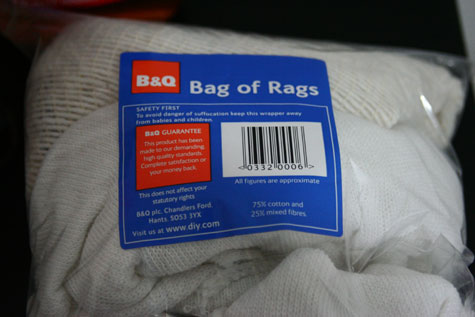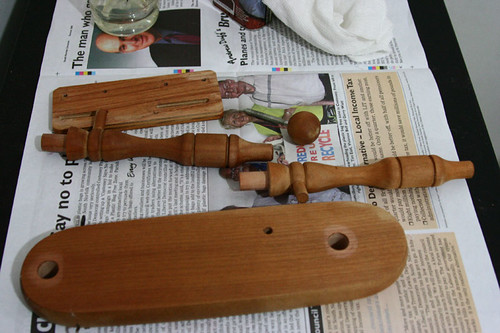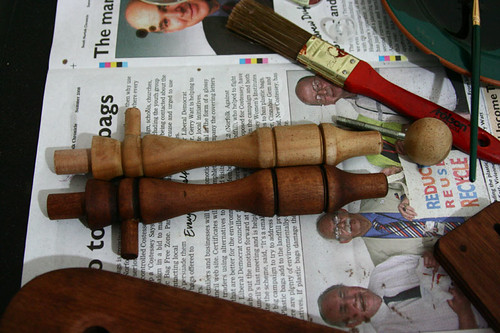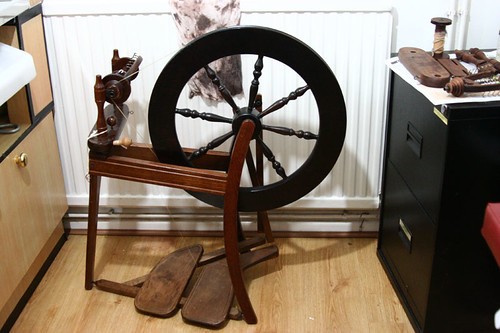I’ve just realised I’ve been neglecting my blog a little recently. I keep thinking of things to write about, then I write them on a forum on ravelry and don’t put them on here. I just spent half an hour typing up a post about longdraw, so I thought i would share it here.
Firstly, some of you may be asking what is longdraw? Well, it’s a drafting technique which, when used with rolags, allows you to produce a woollen yarn. Not ‘woollen’ as in ‘made from wool’, but woollen meaning a light and airy yarn which combines the long and short fibres from a fleece, wrapped round a core of air, making for a fluffy, bouncy, lofty yarn. This technique can be used for spinning other types of prep making a technically semi-woolen yarn, but with the same fluffy properties (though only spinning from rolags will give you the air core).
The technique relies on one of the properties of yarn (well, of any thread), that is, that twist will build up in thin areas, leaving the thicker areas untwisted. As you pull back, the twist holds together the thin areas, and thins out the thicker areas so you end up with an even single. This is why using a good prep is essential; if the fibres are long and running parallel to the yarn, some fibres from the thick areas will get trapped in the thinner areas and your lumps will be ‘locked’ in place. With a rolag, the fibres are running perpendicular to the length of the yarn, they will be pulled diagonally as you draft, so they overlap and the yarn doesn’t disintegrate, but the end result will be fibres that travel in a corkscrew path along the length of the yarn, rather than fibres all aligned straight and parallel twisted around each other. This method allows very short stapled fibres such as cashmere to be spun with ease, where a short forward draft would be difficult and time consuming.
These tips are aimed for people looking to try longdraw who have never done it before, they are just a few small things I found helpful when first starting. This isn’t a technique I’d recommend for beginning spinners, short forward draws are a lot easier to learn and do from commercially prepped tops/roving, which are easily available. Of course, in the past when using a great wheel, and in countries where cotton is the only available fibre for beginners, people did/do start off with a longdraw method (though maybe great wheel spinners started on spindles?), and they cope just fine, but given the tools and fibre preps available to us today, complete beginners will probably find themselves making yarn a lot more quickly and easily using another technique. This post is designed to help more experienced spinners who are comfortable with spinning and know their way around their wheel, but who want to add the longdraw technique to their spinning arsenal.
– First, pick your fibre. It’s possible to do longdraw from almost anything, but the easiest to start off with is well carded rolags of a medium fineness, medium staple (around 3 inches), nicely sproingy wool. I think my first longdraw was done using rolags from a jacob fleece, but i might have forgotten something else I used. Either way, airy preps like rolags or batts are a lot easier than roving.
– attach the fibre to your leader and spin the first foot or so using whatever drafting style you’re comfortable with. While it is possible to longdraw right from the start, when you’re first starting it’s harder to get this join right, and set the thickness of the yarn you want…starting from a patch of ready spun yarn is easier.
– You want your tension to be just high enough that it winds the yarn on quickly when you let it, but low enough that it doesn’t try and pull the yarn out of your hands. A higher ratio than you’d normally use for the particular thickness of yarn is desirable, but not essential, if your wheel only has one ratio, you can just treadle more before and after the draft to make up for it.
– start off holding your rolag with a few inches of ready spun yarn in front of the orifice, this will hold some twist and allow it to be redistributed throughout the part you draft.
– with your back hand (in my case, my left), pinch off a bit of your rolag. The exact amount will depend on the thickness of yarn you’re wanting to spin, but an inch or two is normally plenty…err on the side of too little at the start….too little and your drafting length will be shortened, too much and you’ll need a magic extendable arm to pull the fibres out long enough. Unless you have such a magic arm, the result will be that your yarn is very lumpy.
– Use the thumb and first finger of your front hand to hold the yarn just in front of the orifice. It’s this that you’ll be pulling back against. If you’ve built up enough twist in the few inches of already drafted yarn, this hand can stay in place until the end of the draft, but chances are you’ll have to open your fingers a couple of times during the draft to allow more twist in to hold the yarn together.
– pull back with your back hand, it’s a fast draft compared to short draw, but it isn’t THAT fast a movement, it should be fluid. Watch the yarn. You’ll see it break into big lumps held together by thinner areas. If you’ve got enough twist there, continuing to pull back will smooth out the lumps, leaving the thin areas as they are. If you see the yarn start to drift apart due to lack of twist, allow some more in with your front hand. Keep pulling back until there are no more thick spots (the yarn won’t be totally even, so don’t worry too much, most unevenness will come out in the plying).
– wait, and treadle. This is a long draft in a short period of time, you’ll need to treadle for a while to make up for it and get enough twist into the yarn before allowing it to wind on. Using a fibre of varigated colour makes this part easier as you can see the angle of twist so you won’t need to be stopping to check plybacks all the time. After a while you’ll get into a routine and know how many treadles you do while drafting, and how many to do afterwards.
– Pay attention to the feel of the yarn with your back hand. It’s reaaaaaally hard to explain, but once you’ve got it, you’ll be going by feel, it feels almost like you’re pulling on a piece of elastic. The feeling is probably the most important thing in terms of setting your drafting speed, and the hardest to explain.
That’s all i can think of at the moment…I hope it helps. If your computer is up to it, watch a few youtube videos to see different people’s styles…this vid is good cos you can see exactly what both her hands are doing: http://uk.youtube.com/watch?v=z92IpGYh8RE.
Be aware that the american and english longdraw are different…both are still longdraw, they both involve drafting way more than the staple length of fibre, but there are slight differences in what your hands do….which are explained in this post: http://spinningspiderjenny.blogspot.com/2006/11/drafting-…. What I’ve explained above is the english longdraw, personally I find the american unsupported longdraw the most fun cos i can do it one handed, but its a little fiddlier to do cos I find you need to mess with your tension a little more to get it right, and its harder to explain as a step by step process, as it relies on how the yarn feels even more so than the english version.
I hope this helps some of you on your path to longdraw fun, and if anyone reading this (does anyone actually read this??) has any questions, just ask in the comments and I’ll answer in a later post.















